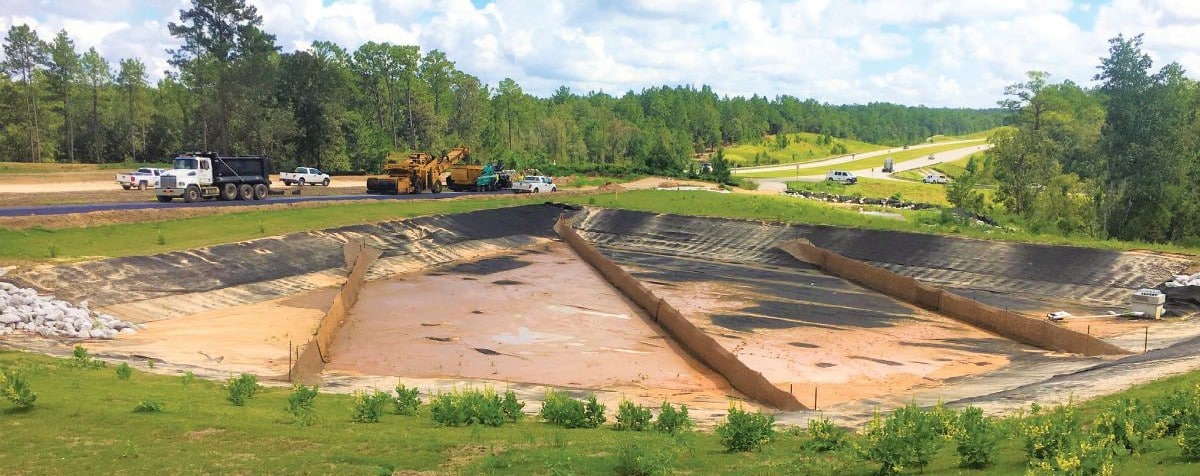
Sediment control alone is ineffective. Period.
No sediment or turbidity management practice can be fully effective unless it is employed as a part of a system. Preferably, the system includes the application of the Five Pillars of Construction Stormwater Management: managing communication, managing work, managing water, managing erosion, and managing sediment. The order of the steps is key—they are listed in order of effectiveness and economy.
This article is an attempt to communicate the state of practice for sediment basin design and operation. The state of practice described herein is based on the findings of current research and nearly two decades of personal trial and observation, compiled by one stormwater professional who prides himself on paying attention to these sorts of things.
The Knowing-Doing Gap
The sediment basin was first recognized as a best management practice (BMP) for managing construction-related stormwater runoff more than 40 years ago. Since then, practitioners, researchers, and regulators have provided information and direction that have caused elements such as floating skimmers, flow baffles, and temporary and permanent linings to become standard. This evolution has caused the “best” sediment basin practices and configurations to become better over time, yielding today’s BMPs. That is good news.
The bad news is that in spite of all of the research, learning and practice advancement, the state of implementation often does not reflect the profession’s state of knowledge. Many sediment basins in use today lack basic design, construction and operation elements, and principles developed through many hours of hard work and careful observance. It is the responsibility of the stormwater professional to continually take opportunities to widen the knowing-doing gap by learning, then narrow that gap through implementation.
Unexpected Outcomes in the Field
Narrowing the knowing-doing gap requires change—and change is hard. Sometimes change is predictable, but oftentimes it is not. Fortunately, even surprises that come with negative outcomes can be looked back upon favorably if they are declared to be learning experiences. The following examples brought learning and, ultimately, an evolution ineffectiveness that has been applied to future projects.
The Bypass. Part of this linear project drained to one of the most biodiverse streams in the world: the Cahaba River in Alabama. In an attempt to apply the latest knowledge of the day, sediment basins were inserted into the project design process as a late add-on. The first rain event brought a lesson in properly sizing basins for capacity, rather than just squeezing them in, and also showed the purpose and value of the forebay, which was not included in the design. A successful attempt was made to include all of the necessary elements, including baffles, skimmers, stabilized inlets and flocculant.
The unfortunate surprise came when all of those turbidity- polishing provisions had to be excavated from feet of deposited sediment. The lesson that sediment control alone is ineffective was also reinforced.
The Beltline. Owner permission was given on this project to experiment and use as many tools as necessary to ensure that regulatory requirements and stakeholder expectations were fully addressed. Sediment basin capacity was expanded during design from the minimum required 3,600 cubic feet of volume per acre of the drainage area to handling the two-year, 24-hour storm (4.1 inches). In addition, an item for “active treatment” was added to the contract for the contractor to choose how best to achieve discharge turbidity standards of no more than 50 NTU more than that of the receiving water.
One expectation was that an extremely expensive active runoff treatment system would be provided. The unexpected outcome was that, through contractor innovation, a simple recirculating system was proposed and adopted, saving the owner and contractor several hundreds of thousands of dollars. The system consisted of a rented pump, an inexpensive PVC manifold, and flocculant. Captured runoff water recirculated until water quality met the discharge standards.
Safe 98. Formerly known as “Muddy 98,” this highly publicized project changed the face and future of an entire stormwater program. Significant lessons were learned during and after a season of mismanagement and negative consequences more than a decade ago. After a 10-year hiatus, construction has resumed on this important transportation corridor in Alabama.
The two-year, 24-hour storm event for the coastal project area is 5.7 inches—likely too great for a practically designed and implemented sediment basin volume. To account for the lack of designed capacity, the project inspection staff and environmental quality assurance team from Volkert Inc. made sure that sediment basins were excavated to fill all available space to increase treatment capacity.
The unexpected outcome was realized and reinforced with ever-increasing rain events, including those associated with tropical storms in the coastal city and hurricanes in the region. The project continues to receive rains reaching up to 4.5 inches in less than 24 hours, sometimes after days of consecutive storms. To date, after nine months of construction, and in spite of the heavy precipitation, some skimmer outlets have never floated. Due to the sandy nature of the soils on-site and in the watershed, the majority of potential runoff simply does not make it to the basins before infiltrating.
It is fully expected that this article will become dated and may become irrelevant over time. The state of practice for sediment basin design and implementation may advance to a level of effectiveness that the recommendations here may no longer be the best.
However, as of the date of the writing of this article, and limited by the experience and knowledge of the author, ideally, the most effective sediment basins have many of the following characteristics.
- The basin is designed to hold the two-year, 24-hour storm event.
- The basin length is at least twice its width, conforming to existing and proposed topography to minimize excavation.
- A forebay (or a collection of practices to remove heavier particles) is provided prior to runoff entry into the basin.
- Runoff is dosed with a soil-matched flocculant and fully mixed as the concentrated flow enters the basin.
- An appropriately stabilized basin inlet is provided.
- Permanent vegetation on side slopes is established with solid sodding or with seed and an appropriate rolled erosion control product.
- The basin bottom is level and protected with a rolled erosion control product or geotextile fabric (whichever is the less expensive option).
- Coir flow baffles with 25 percent effective openings are provided at approximately one-third points, perpendicular to the flow.
- A manual outlet valve remains closed until the quality of the discharge meets applicable water quality standards.
- The basin is dewatered from the surface over a period of time that allows capacity restoration before the next storm.
- Simple recirculating active treatment, as described above, is employed if capacity must be restored prior to acceptable water quality being achieved by passive treatment.
- An appropriately designed auxiliary spillway is provided (it is not an “emergency” spillway if it is appropriately designed).
Final Notes
It must be stated again that sediment control alone is ineffective. This article addressed only one practice in the critical, but a least effective, and most expensive category of the Five Pillars. The most successful projects are planned, designed and constructed with a holistic mindset and approach.
Also, acknowledgment is given that not every sediment basin can be practically designed or constructed to meet the ideal standards above. However, the pursuit of perfection often yields a level of excellence and effectiveness that can buffer against the many uncontrollable variables that haunt the construction stormwater professional.
About the Expert
Barry Fagan of Volkert Inc. is a stormwater professional whose mission is to help good people get better at managing stormwater.
This article was originally published in the July/August issue of the International Erosion Control Association’s (IECA) Environmental Connection publication.

